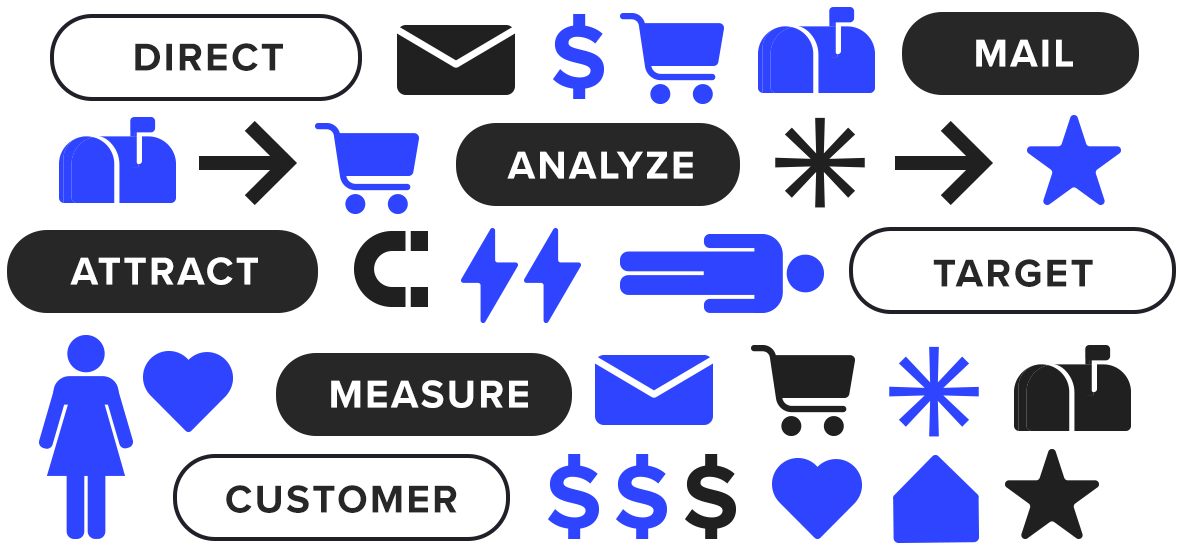Create a Winning Message for Your Direct Mail Campaign
Direct mail can be a great way to let new customers know about your product or service. But to really pique their interest, you need a compelling message.
- Who are my target customers?
- What do my customers need?
- What message will spur customers to buy?
- How can I get customers to believe in my company?
- What actions do I want them to take?
- How can I monitor how well my campaign is working?
Answering these questions can help you create a successful mailpiece that delivers higher response rates and greater return on your investment.
Who Are Your Target Customers?
Your customer base is a great resource to help you increase return on investment (ROI) from your direct mail campaign. You’ll get the best ROI from your direct mail campaign if you focus your message on the people most likely to buy. One way to do this is to find out everything you can about your current customers. Then target your mailing to people like them.
Try to Learn About Your Customers

TIPS:
Even if you don’t have a big budget for market research, you still have ways to gather information.
- Post a survey on social media or your website and give customers an incentive to complete it—maybe enter their names in a drawing.
- Invite a few friendly customers to coffee and interview them.
- Follow consumer trends for your target audience to learn more about what they like and don’t like.
What Do Your Customers Need?
As you’re crafting your direct mailpiece, remember this: Your message should not be all about your product. It should be about your customers’ needs and wants. So rather than detail all the features of your product, tell potential customers how it’s going to make their lives better. For instance, if you’re selling home security systems, talk about peace of mind and safety before talking about the type of sensors you use. It’s important to create a clear picture of your customers’ needs and how your business is uniquely qualified to meet them.
TIPS:
Analyze the data you gathered about your customers and put yourself in their shoes.
- What interests and challenges do they have?
- How does your product help them meet those challenges?
- What one or two special things do you do better than your competitors that can make customers’ lives easier?
- Think about what questions customers might have when they’re just becoming aware of your product. For instance, what does your product offer compared to another?
What Message Will Spur Customers to Buy?
- Offer special pricing. For instance, would offering 10% off services for new customers at your salon persuade them to try you out?
- Make your offer time sensitive. A limited-time promotion encourages immediate action.
TIPS:
Make sure what you’re offering makes sense for your business.
- Don’t give away more than you can afford.
- Limit special deals to one per customer.
- If you can’t afford to offer a discount, think of other incentives you might give new customers—maybe a free consultation or a giveaway of overstocked products.
How Can You Get Customers to Believe in Your Company?
- Numbers and statistics to prove that your product works.
- Quotes from experts.
- Testimonials from satisfied customers.
- A free trial or a money-back guarantee.
TIPS:
Leverage survey results and reviews.
- Do you have survey results pointing to what people like about your business? For instance, would a high percentage of users recommend you to a friend? If so, put that on your mailpiece.
- Feature positive comments from review sites in your mailpiece, if permitted by the sites’ terms and conditions and with permission from the authors. Introduce the reviews with “Here’s what people are saying about us.”
What Actions Do You Want Them to Take?
A strong call to action (CTA)—a clear statement that tells readers what to do next—is critical. For instance, tell customers to call this number now to get 40% off, visit this URL to redeem your coupon, or scan this QR Code®[1] to buy now. Your CTA should be relatively short—generally no more than a sentence or two.
If you’re creating a longer piece of mail, such as a letter, use the CTA more than once. Naturally, you’ll want to close your message with it. But since not everyone will read to the end, find ways to intersperse the CTA throughout your offer.
TIPS:
Construct a strong CTA.
- Use strong command verbs that tell recipients exactly what to do.
- Keep it short and to the point. Aim for 25 words or fewer.
- If you have room, repeat information about special deals, limited-time offers, or guarantees that you mentioned earlier.
Monitor How Well Your Campaign Is Working
As you’re creating your mailpiece, think about how you’re going to track the response to it. If you have a complicated campaign involving multiple channels—such as email, paid search, etc.—sophisticated computer models can help you track how much difference each channel is making.
- Use a personalized URL (PURL) for each recipient. When a prospect visits the PURL, you’ll know your mailpiece worked. Vanity URLs, short URLs that are not personalized for each recipient but are specific to a particular direct mail campaign, are another way to track response.
- Include a QR Code that customers can scan using an app on their tablet or smartphone. You may want to give them an incentive to use the code, such as a coupon.
- Include a toll-free number that is specific to the direct mail campaign.
- Use a coupon code that customers must bring to your store or enter on your website to receive a discount.
- Use USPS® Informed Delivery® notifications to enable consumers to link to your website through a digital preview of your physical mailpiece.[2] This allows you to more easily track results. You can learn more at the Informed Delivery for Business Mailersarrow_right_alt webpage.
TIPS:
Keep in mind that you may not capture all of the responses to your direct mail. Customers may read your mailpiece and later search online for your product without using the special URL or QR Code to get there. So the actual response may be greater than it appears.
Sample Use Case: Health Club Targets New Members
Challenge:
A health club plans to send out a mailer to recruit new members but needs more information on its prospects so it can deliver messages that resonate. The club has already gleaned some valuable data such as age, gender and residence from the forms that members fill out when they join, but this is not detailed enough. In order to gather additional information, the club plans to offer free water bottles for members who fill out surveys. It can then use the information gathered to target prospects most likely to respond.
Data Analysis:
The surveys reveal that low cost, cleanliness and ample workout equipment are more important than the availability of personal trainers, free towel service, or adding services such as sports massage. The health club also finds that about 40% of the respondents have bachelor’s degrees. And that their main reasons for joining the gym are to improve their appearance, self-esteem and health—but they don’t have a lot of money to spend.
Solution:
After analyzing the information gathered, the company’s leaders decide to use a mailing list that targets prospects age 20 to 50 who earn $30,000 to $60,000 a year and live within five miles of the gym. The club will emphasize low cost and use well-lit, clean-looking images showing people working out. The mailer will emphasize the benefits that speak to this demographic by including phrases like “build a better you” and “look and feel better.” And to entice prospects to act, it will offer 20% off the first month’s fees for a limited time. To address any fears of dissatisfaction, the club will also include a testimonial from a current, happy gym member and an offer to refund the first month’s fees if a new member is not happy with their experience.
Call to Action:
To encourage response, the mailpiece will close with a clear, strong call to action that tells prospects to act now before the promotion ends and reminds them of all the benefits: “Start getting fit today. Visit our website or stop by today to get 20% off your first month.” A URL on the mailpiece will direct customers to the promotional sign-up page on the gym’s website.
Get the Right Messages to the Right People
Following these best practices can help you get the most return for your marketing dollar. Done right, direct mail can be a powerful marketing tool to attract new customers. This is because it helps you deliver targeted marketing messages that are more customized and relevant.
Today’s direct mail can help you deliver hyper-targeted messages based on more in-depth information like interests, spending habits, online and offline shopping behavior, and product usage. This matters because the more precise and personal your content is, the greater the impact and stronger the call to act—which can ultimately help you increase conversion rates and your bottom line.
Learn Even More
For an in-depth look at creating a direct mail campaign from start to finish, see our comprehensive tutorial, “8 Steps to Successful Direct Mail.”

 search
close
menu
search
close
menu




